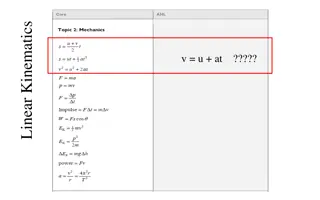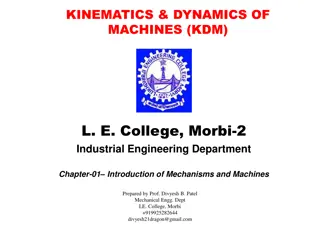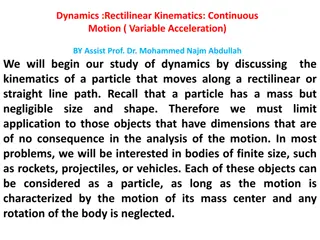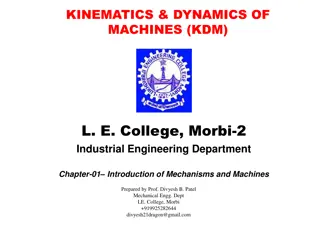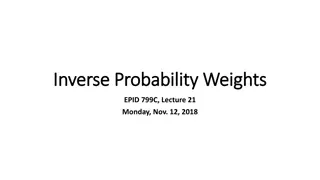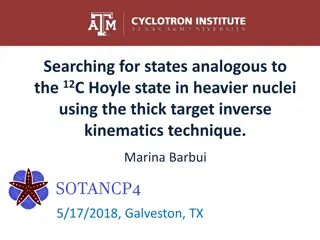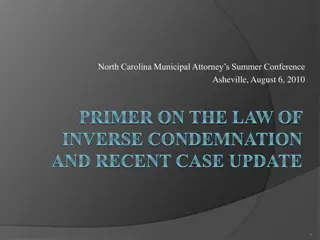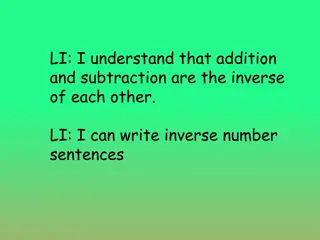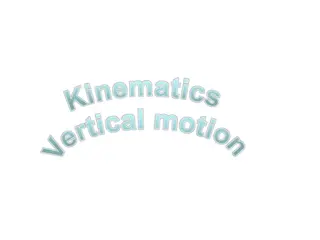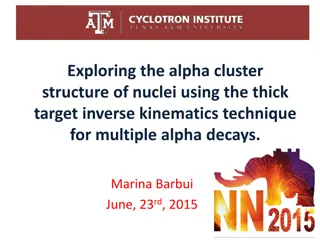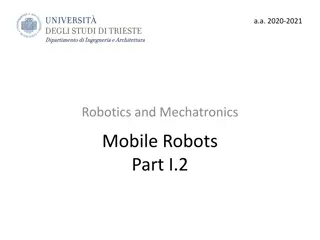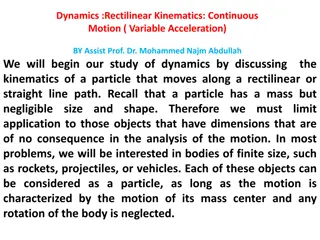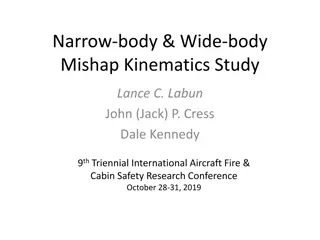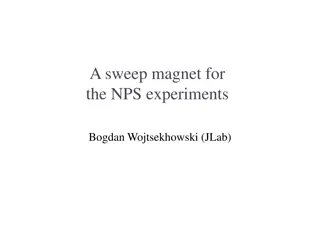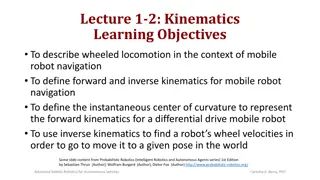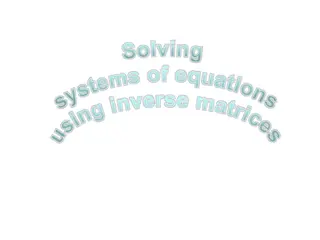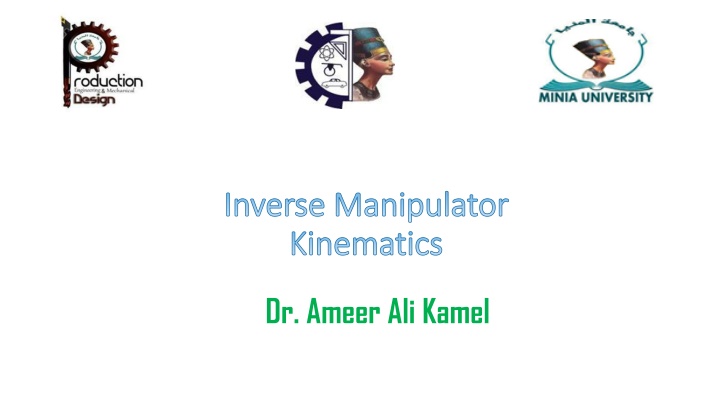
Solving Inverse Kinematics in Manipulators: The Challenge of Workspace
Explore the complexities of solving inverse kinematics in manipulators, focusing on workspace considerations and limitations for achieving desired end-effector positions and orientations. Understand the dextrous and reachable workspace concepts and the impact of joint limits on manipulator capabilities.
Uploaded on | 0 Views
Download Presentation

Please find below an Image/Link to download the presentation.
The content on the website is provided AS IS for your information and personal use only. It may not be sold, licensed, or shared on other websites without obtaining consent from the author. If you encounter any issues during the download, it is possible that the publisher has removed the file from their server.
You are allowed to download the files provided on this website for personal or commercial use, subject to the condition that they are used lawfully. All files are the property of their respective owners.
The content on the website is provided AS IS for your information and personal use only. It may not be sold, licensed, or shared on other websites without obtaining consent from the author.
E N D
Presentation Transcript
Inverse Manipulator Inverse Manipulator Kinematics Kinematics Dr. Ameer Ali Kamel
This lecture is focused on the direct kinematics of manipulators, here the focus is the inverse kinematics of manipulators. Solving the problem of finding the required joint angles to place the tool frame, {T}, relative to the station frame, {S}, is split into two parts. First, frame transformations are performed to find the wrist frame, {W}, relative to the base frame, {B}, and then the inverse kinematics are used to solve for the joint angles. Inverse kinematic given ??0= ?1?2 ??= ? =? find ? = ?1 ?2 0 ?? 1 ? ???
This is the problem of inverse kinematics, and it is, in general, more difficult than the forward kinematics problem. Existence of Solutions For a solution to exist, the specified goal point must lie within the workspace. Sometimes, it is useful to consider two definitions of workspace: Dextrous workspace is that volume of space that the robot end-effector can reach with all orientations. That is, at each point in the dexterous workspace, the end- effector can be arbitrarily oriented. The reachable workspace is that volume of space that the robot can reach in at least one orientation. Clearly, the dextrous workspace is a subset of the reachable workspace.
Consider the workspace of the two-link manipulator in Fig. If 11 = 12, then the reachable workspace consists of a disc of radius 2 11, The dextrous workspace consists of only a single point, the origin. If 11 12, then there is no dextrous workspace, and the reachable workspace becomes a ring of outer radius 11 + 12 and inner radius ?1 workspace there are two possible orientations of the end-effector. On the boundaries of the workspace there is only one possible orientation. ?2. Inside the reachable
These considerations of workspace for the two-link manipulator have assumed that all the joints can rotate 360 degrees. This is rarely true for actual mechanisms. When joint limits are a subset of the full 360 degrees, then the workspace is obviously correspondingly reduced, either in extent, or in the number of possible orientations attainable. For example, if the arm in Figure has full 360- degree motion for 01, but only 0 <02 <180 , then the reachable workspace has the same extent, but only one orientation is attainable at each point. When a manipulator has fewer than six degrees of freedom, it cannot attain general goal positions and orientations in 3-space. Clearly, the planar manipulator in Fig. cannot reach out of the plane, so any goal point with a nonzero Z-coordinate value can be quickly rejected as unreachable. In many realistic situations, manipulators with four or five degrees of freedom are employed that operate out of a plane, but that clearly cannot reach general goals. Each such manipulator must be studied to understand its workspace.
Workspace also depends on the tool-frame transformation, because it is usually the tool- tip that is discussed when we speak of reachable points in space. Generally, the tool transformation is performed independently of the manipulator kinematics and inverse kinematics, so we are often led to consider the workspace of the wrist frame, {W}. For a given end-effector, a tool frame, {T}, is defined; given a goal frame, {G}, the corresponding {W} frame is calculated, and then we ask: Does this desired position and orientation of {W} lie in the workspace? In this way, the workspace that we must concern ourselves with (in a computational sense) is different from the one imagined by the user, who is concerned with the workspace of the end-effector (the {T} frame). If the desired position and orientation of the wrist frame is in the workspace, then at least one solution exists.
Multiple Solutions Another possible problem encountered in solving kinematic equations is that of multiple solutions. A planar arm with three revolute joints has a large dextrous workspace in the plane (given "good" link lengths and large joint ranges), because any position in the interior of its workspace can be reached with any orientation. Figure shows a three-link planar arm with its end-effector at a certain position and orientation. The dashed lines indicate a second possible configuration in which the same end-effector position and orientation are achieved.
The fact that a manipulator has multiple solutions can cause problems, because the system has to be able to choose one. The criteria upon which to base a decision vary, but a very reasonable choice would be the closest solution. For example, if the manipulator is at point A, as in Fig, and we wish to move it to point B, a good choice would be the solution that minimizes the amount that each joint is required to move. Hence, in the absence of the obstacle, the upper dashed configuration in Fig. 4.3 would be chosen. This suggests that one input argument to our kinematic inverse procedure might be the present position of the manipulator. In this way, if there is a choice, our algorithm can choose the solution closest in joint-space. However, the notion of "close" might be defined in several ways. For example, typical robots could have three large links followed by three smaller, orienting links near the end-effector. In this case, weights might be applied in the calculation of which solution is "closer" so that the selection favors moving smaller joints rather than moving the large joints, when a choice exists.
The presence of obstacles might force a "farther" solution to be chosen in cases where the "closer" solution would cause a collision in general, then, we need to be able to calculate all the possible solutions. Thus, in Fig. the presence of the obstacle implies that the lower dashed configuration is to be used to reach point B.
The number of solutions depends upon the number of joints in the manipulator but is also a function of the link parameters (a1, a1, and for a rotary joint manipulator) and the allowable ranges of motion of the joints. For example, the PUMA 560 can reach certain goals with eight different solutions. Figure shows four solutions; all place the hand with the same position and orientation.
For each solution pictured, there is another solution in which the last three joints flip" to an alternate configuration according to the following formulas: So, in total, there can be eight solutions for a single goal. Because of limits on joint ranges, some of these eight could be inaccessible.
In general, the more nonzero link parameters there are, the more ways there will be to reach a certain goal. For example, consider a manipulator with six rotational joints. Figure shows how the maximum number of solutions is related to how many of the link length parameters (the ai) are zero. The more that are nonzero, the bigger is the maximum number of solutions. For a completely general rotary-jointed manipulator with six degrees of freedom, there are up to sixteen solutions possible
Method of solution We will split all proposed manipulator solution strategies into two broad classes: closed-form solutions and numerical solutions. Because of their iterative nature, numerical solutions generally are much slower than the corresponding closed-form solution; so much so, in fact, that, for most uses, we are not interested in the numerical approach to solution of kinematics. Within the class of closed-form solutions, we distinguish two methods of obtaining the solution: algebraic and geometric.
EXAMPLE Give a description of the subspace of 2 the polar manipulator with two degrees of freedom shown in Fig. 0? for The subspace can therefore be given as
Usually, in defining a goal for a manipulator with n degrees of freedom, we use n parameters to specify the goal. If, on the other hand, we give a specification of a full six degrees of freedom, we will not in general be able to reach the goal with an n < 6 manipulator. In this case, we might be interested instead in reaching a goal that lies in the manipulator's subspace and is as "near" as possible to the original desired goal.

